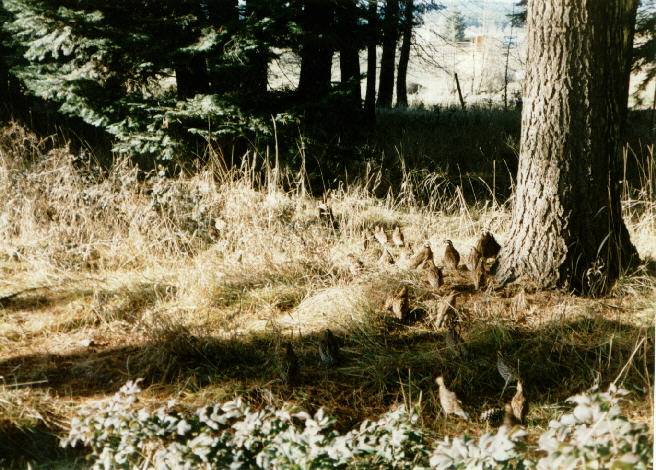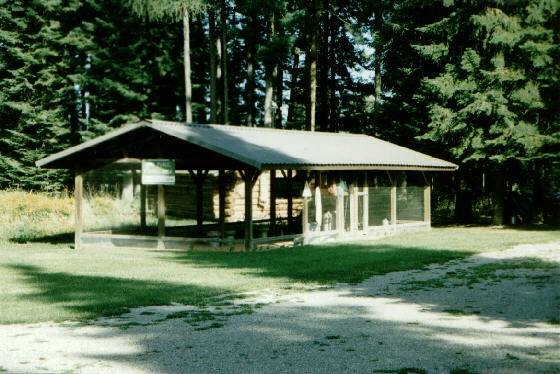Bird Dogs...
Quail...
Resources...
Library...
Dog Training Collars
Tri-Tronics
SportDog
Dogtra
Innotek
The Quail Program Video
| CD-ROM video preview offer |
Every once in a while, something comes along completely out of the blue and shakes up the theory that unsolicited e-mail is junk. Such was the case recently when I received a message from a gentleman named Dale Davis. Having stumbled into this site, Dale wrote to tell me about a video he made, the purpose of which he described as "meant to take the guesswork out of trying to raise quail for dog training or releasing into the wild". He graciously offered to send me a copy to watch at my leisure, and in one of the better decisions I've recently made, I accepted.
 |
Dale Davis' pen |
On a fairly regular basis, site visitors write and ask questions about raising quail. These run the gamut from "where do I get eggs?" to "how do I go about releasing quail?" to "does my johnny house need perches?". It is a subject on which I am not very well versed, so unless the question is rudimentary, I usually refer the visitor to one of several sites that are more devoted to quail breeding than quail hunting. But based on the number of e-mails I receive, it is evident that there are quite a few people interested in raising quail, releasing quail, and/or using quail to train their dogs. After viewing the video, I felt that it would greatly benefit anyone with such an interest.
I should state at the outset that this video itself is not is a step-by-step, detailed, how-to of raising quail. Details along these lines are included in a multi-page letter and CD that come with the video. What the tape includes is a bevy of tips gleaned from Dale's successes and failures over his twenty years of raising quail.
Narrated by Dale himself, the video begins with a general discussion of incubating, hatching, and brooding quail chicks. His tone is gentle and unassuming as he talks about and demonstrates the methods he's used to maximize his hatch and survival rates, expected time periods for each stage of the process, and certain pieces of equipment that he prefers for one reason or another. This is not a commercial for any specific product, however, and with the exception of one instance, he does not offer suggestions on prices and suppliers. If you are interested in these details, I did find him to be most helpful and willing to share this information by phone and e-mail.

|
At approximately a month of age, Dale transitions the birds from the brooder to the pen, and this is where the fun begins. Strangely enough, there is no real science to this part, just a dose of faith and a good deal of patience. The keys seem to be gradually exposing the birds to the outside world while being diligent about providing food and shelter for them inside the pen. As you can see in the photo, Dale's pen is constructed for working with larger numbers of quail, but his process applies to a johnny house built for a couple of dozen birds with the caveat that a smaller population leaves you more vulnerable to predators and natural attrition. "Keep in mind that I let at least half out every day so they can get the education they need to survive," he says. "This is the main difference between what I do and what everyone else does. It's several months from the time you start to maturity and I feel it's a numbers game. They don't all have the same aptitude so some will make it and some won't."

|
We corresponded about problems with predators invading the pen, and he acknowledged that it does happen on occasion. He shared several methods of removal for such times and mentioned that he once dispatched a feral cat inside the pen and watched curiously as the quail ran to the remains. Predators are not the only visitors Dale has encountered, though. The photo at the right shows a covey of wild Valley quail that wandered into the pen on their own.
Hunters who work their dogs on pen-raised quail would likely tell you that their biggest beef with these birds is that they just don't behave like wild quail. Due to the paucity of readily available wild birds in most parts of the country, most of us have suffered the less-than-satisfying experience of kick-starting a covey of planted quail. Disappointing is a fair description of having to swing a boot through the grass to get birds into the air and, at least in my experiences, the kicking and shuffling of grass in front of a dog on point is sometimes more temptation than a dog can bear. As often as not, the grass dance sends the birds off in close contact with the earth. With you in hot pursuit, they scurry along the ground, darting from side to side and hiding under anything resembling cover. Again, not the ideal experience for a young dog.
From my perspective, Dale seems to have this problem under control. The most impressive parts of the video, without question, were the displays of his birds in flight. On their early outings from the pen, the birds behaved like most pen-raised quail: slow, fluttering flight and short hops. Four or five weeks of conditioning to the outside world resulted in behavior that was dramatically different. When flushed, the birds departed as quickly as any wild covey and did so without any shuffling or kicking of the grass. Rather than hopping twenty or thirty feet as pen-raised birds often do, they cleared the immediate area, also a tremendous benefit to the man training a young dog. These birds had indeed learned to behave like wild quail, and for those of you who have paid for pen-reared quail that flew like a penguin, that alone is worth the cost of the video.
Some people may get a mild case of sticker shock when they see the $50 price tag (shipping included). It does seem like a lot for a video, but when you look at it from another perspective, the price seems infinitely more reasonable. Raising quail requires an investment in equipment and time. Return on that investment depends primarily on your ability to successfully hatch and raise the chicks to adulthood, at which point you can sell them or train with them. With most breeders selling quail between $2.50 and $5.00 per bird, you can do the math to see that the video is a swap at about ten to twenty birds. Are you losing more birds than that during hatching and training?
If you're merely looking for a set of johnny house plans, look here. But if you're a first-timer, a frustrated novice, or a dog trainer searching for a solution to your lack of spirited birds, spend 90 minutes watching this video. And if your questions still aren't answered, give Dale a call.
For more information on the full video, visit www.quailprogramvideo.com
For more information on suppliers of breeding equipment, try GQF Manufacturing and Wildlife Harvest Magazine, or give Dale a call at 509-276-8661.
 Windows users press "CTRL+P" to print this page
Windows users press "CTRL+P" to print this page  Mac users press "Apple/Loop+P" to print this page
Mac users press "Apple/Loop+P" to print this page